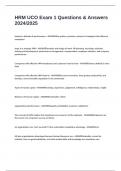HRM UCO Exam 1 Questions & Answers
2024/2025
behavior, attitudes & performance - ANSWERSthe polices, practices, systems & strategies that influence
employees'
steps in a strategic HRM - ANSWERSanalysis and design of work, HR planning, recruiting, selection,
training and development, performance management, compensation, employee relations, and company
performance
Companies with effective HRM employees and customers tend to have - ANSWERSmore satisfied & more
loyal
Companies with effective HRM tend to - ANSWERSbe more innovative, have greater productivity, and
develop a more favorable reputation in the community
Types of human capital - ANSWERStraining, experience, judgement, intelligence, relationships, insight
Behavior of Human Capital - ANSWERSmotivation, effort
organizational performance - ANSWERSquality, profitability, customer satisfaction
The concept of HRM implies that employees are resources of the employer - ANSWERSEmployees are
the source of a company's success or failure
An organization can/ can't succeed if it has sustainable competitive advantage - ANSWERScan
HR give organizations advantages because Human Resources are - ANSWERSvaluable, cannot be
imitated, have no good substitutes, and with needed skills and knowledge are sometimes rare
,An organization in which ______ all work together to give an organization a competitive advantage is an
high performance work system - ANSWERStechnology, organizational structure, people, and processes
HR roles as an - ANSWERSstrategic business partner, change agent and employee advocate are
increasing.
HR is challenged to shift focus from transactional operations to future strategies and capability buildings,
this shift presents two challenges - ANSWERSself service and outsourcing
HR product lines - ANSWERSadministrative services and transactions, business partner services, strategic
partner
administrative services and transactions - ANSWERSresource efficiency and service quality,
compensation, hiring and staffing
Business Partner Services - ANSWERSdeveloping effective HR systems and helping implement business
plans, talent management.
strategic partner - ANSWERSContributing to business strategy based on considerations of human capital,
business capabilities, readiness, and developing HR practices as strategic differentiators
Emphasis: Knowledge of HR and the business, competition, the market, and business strategies.
Analysis and design of work - ANSWERSWork analysis; job design; job descriptions
Recruitment and Selection - ANSWERSRecruiting; job postings; interviewing; testing; coordinating use of
temporary labor
Training and Development - ANSWERSOrientation; skills training; career development programs
Performance Management - ANSWERSPerformance measures; preparation and administration of
performance appraisals; discipline
,Compensation and Benefits - ANSWERSWage and salary administration; incentive pay; insurance;
vacation leave administration; retirement plans; profit sharing; stock plans
Employee Relations - ANSWERSAttitude surveys; labor relations; employee handbooks; company
publications; labor law compliance; relocation and outplacement services
Personnel Policies - ANSWERSPolicy creation; policy communication
employee data and information systems - ANSWERSRecord keeping; HR information systems; workforce
analytics
Compliance with Laws - ANSWERSPolicies to ensure lawful behavior; reporting; posting information;
safety inspections; accessibility accommodations
Support for strategy - ANSWERSHuman resource planning and forecasting; talent management; change
management
Job Analysis - ANSWERSthe process of getting detailed information about jobs
Job Design - ANSWERSthe process of defining the way work will be performed and the tasks that a given
job requires
recruitment - ANSWERSthe process through which the organization seeks qualified applicants (that will
perform better and stay stronger) for potential employment
Selection - ANSWERSthe process by which the organization attempts to identify applicants with the
necessary knowledge, skills, abilities, and other characteristics that will help the organization achieve its
strategic goals
Training Employees - ANSWERSA planned effort to enable employees to learn job-related knowledge,
skills, and behavior
, development - ANSWERSthe acquisition of knowledge, skills, and behaviors that improve an employee's
ability to meet changes in job requirements and in customer demands
Performance Management - ANSWERSthe process through which managers ensure that employees'
activities and outputs contribute to the organization's goals
Planning Pay & Benefits - ANSWERSHow much salary, wages bonuses, commissions, and other
performance -related pay to offer.
Which benefits to offer and how much of the cost will be shared by employees.
Administering Pay & Benefits - ANSWERSSystems for keeping track of employees' earnings and benefits
are needed.
Employees need information about their benefits plan.
Extensive record keeping and reporting is needed.
Maintaining Positive Employee Relations - ANSWERS-Preparing and distributing employee handbooks
and company publications
-Dealing with and responding to communications from employees' questions
-Negotiating union contracts and maintaining communication with union representatives
what is the advantage of establishing and administering policies in organizations? - ANSWERS
Establishing and Administering Personnel Policies on - ANSWERShiring, discipline, promotions and
benefits allows companies to handle situations more fairly and objectively
Workforce Analytics - ANSWERSthe use of quantitative tools and scientific methods to analyze data from
human resource databases and other sources to make evidence-based decisions that support business
goals
Ensuring Compliance with Labor Laws - ANSWERS*Government requirements include:
-filing reports and displaying posters
-avoiding unlawful behavior




